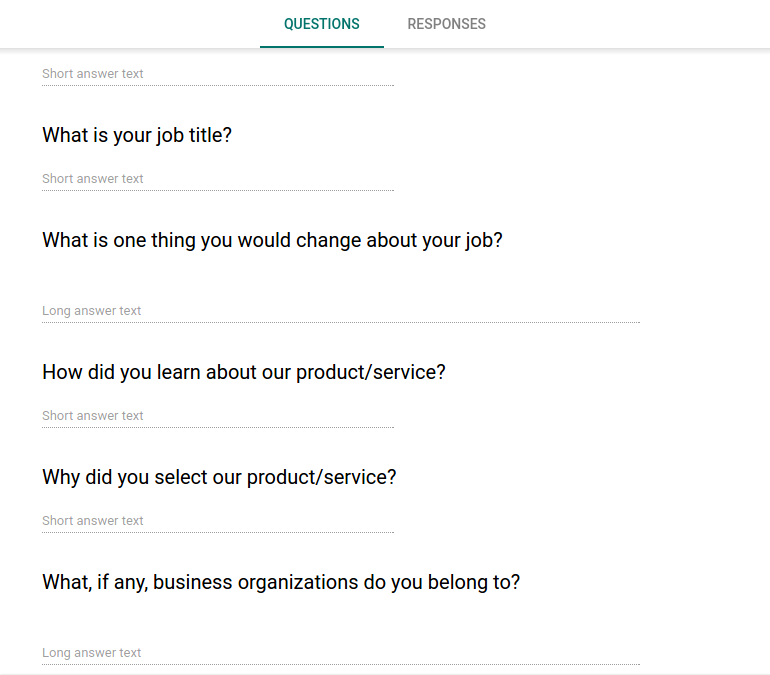People respond much better to targeted marketing than they do to general marketing. Imagine being able to talk to each potential customer directly! We’re a little ways from that but with a combination of tracking, big data, and A.I. improvements I think the future is hyper-targeted marketing.

Until that utopian future (if you are a marketer) or dystopian future (if you don’t like being marketed to) we will have to settle for other methods to target our marketing messages and customer onboarding processes. In order to do that you need to be able to effectively segment your customers in order to tailor your message.
The upside to creating a series of customer profiles (also known as buyer personas) is that your blog content, mailing list emails, and ads will convert better. This is particularly helpful if you place ads on Facebook. The downside is that creating separate content for each segment is a lot more work. But it is work that will pay off in the end.
Customer profile details
For creating profiles I like this character development outline that I used in my college playwriting class. It is called Character Bone Structure and is from Lajos Egri’s The Art of Dramatic Writing. I’ve used it not just for creative writing but for creating buyer personas for my marketing efforts.
PHYSIOLOGY
- Sex
- Age
- Height and weight
- Color of hair, eyes, skin
- Posture
- Appearance: good-looking, over- or underweight, clean, neat,
pleasant, untidy. Shape of head, face, limbs. - Defects: deformities, abnormalities, birthmarks. Diseases.
- Heredity
SOCIOLOGY
- Class: lower, middle, upper.
- Occupation: type of work, hours of work, income, condition of
work, union or nonunion, attitude toward organization,
suitability for work. - Education: amount, kind of schools, marks, favorite subjects,
poorest subjects, aptitudes. - Home life: parents living, earning power, orphan, parents
separated or divorced, parents’ habits, parents’ mental
development, parents’ vices, neglect. Character’s marital
status. - Religion
- Race, nationality
- Place in community: leader among friends, clubs, sports.
- Political affiliations
- Amusements, hobbies: books, newspapers, magazines he reads.
PSYCHOLOGY
- Sex life, moral standards
- Personal premise, ambition
- Frustrations, chief disappointments
- Temperament: choleric, easygoing, pessimistic, optimistic
- Attitude toward life: resigned, militant, defeatist.
- Complexes: obsessions, inhibitions, superstitions, phobias.
- Extrovert, introvert, ambivert
- Abilities: languages, talents.
- Qualities: imagination, judgment, taste, poise.
- I.Q.
(You can bet the door-to-door salesmen of yesteryear would attempt to learn these about a customer within moments of the door opening.)
Obviously this goes into a great deal of detail and some of it you definitely don’t need (but let the data tell you what you need and don’t!). You can probably make things a bit simpler to start with. If you are targeting consumers you can start by using the following four variables or even less:
- Gender
- Age (brackets of ten years)
- Marital status
- Income
2 options for gender * 5 options for age (20s, 30s, 40s, 50s, over 60) * 2 options for marital status * 2 options for income (keep it simple with over/under an income figures such as $50,000) = 40 different possible customer profiles.
You can see that the more variables you use vastly increase the number of profiles. So, start with just a few variables that you deem important and work from there. And don’t be afraid to repurpose content or create content that spans profiles. Depending on your product somebody married in their 30s is not going to be all that different from somebody married in their 40s.
When selling to small businesses a few simple variables to start with might be:
- Industry
- Role (owner or employee)
- Revenue
This is not a substitution for picking up the phone and talking to customers. The more you talk to and engage your potential customers the more you will learn about them. Whenever you are in doubt about something in your business talking to customers will go a long way towards helping you find an answer
Creating customer profiles
Here are a few steps to help you being filling in your customer profiles:
1. Identify the data you already have
You might already have some data on your customers but might not know it. If you use a CRM system for sales it likely has some data in there about your customers. (If it doesn’t you should definitely add some custom fields in order to start recording things such as company size, industry, current solutions they use, and any personal details about your contact that they mention.)
Where you definitely have some hidden data is in your email. Most business people use email signatures which typically contain a few good pieces of information you can use. Here are a few things you can probably glean from a signature and then supplement by looking them up on LinkedIn (a great task for a virtual assistant):

2. Go to where your customers hangout
Facebook groups, LinkedIn groups, and Twitter are all places you can look at to find people talking about the problem that your product or service solves. Look at the discussions they are having and the people that are having them. You should be able to fairly quickly identify a few buckets that your potential customers fall into.
As an experiment (the Underdog Action Plan for the week) create and write down three basic profiles and then try to put twenty people into the bucket that you think best fits them. You’ll probably get most of them, particularly if you did early customer development, but you also might find that the most vocal people online are not potential customers but just people with too much time on their hands. Reach out to the twenty people you assigned to a bucket and see if you can ask them a few questions.

Pro tip: 44% of U.S. consumers go straight to Amazon to search about products. Read the reviews people leave on books and products related to your industry to learn about your potential customers.
3. Ask your customers directly
It is always best to pick up the phone and talk with a customer directly. However you can also leverage technology to get their feedback at various points throughout your relationship such as when they visit your website (I’m sure you have been asked to fill out a survey on a website), when they become a customer, and later after they have used your product or service. This is an example for a questionnaire for a new customer.
Using Google Forms you can easily create a customer feedback form and ask them to fill it out. From “Start a New Form” select the “Customer Feedback” form. You might need to click on “More” in which case you will find it listed under the “Work” forms.
Click on the “Feedback Type” question and then click on the trashcan to delete it. Now click on the “Name” field followed by the plus icon on the right. Add in questions about the customer that you can use to create profiles:

Don’t add too many or you risk people not responding. Ideally it should take somebody just a minute or two to answer all of the questions.
After you have finished click on “Send” in the upper right and then click on the paperclip icon to get a link to send to your new customers. As the results come in you can view them from inside forms or, even better, view the data in Google Sheets so that you can analyze it.
Customize and convert
Knowing somebody’s background and ambitions can really change the language you use when describing your value proposition. Appealing to your customer’s interests is imperative to generating sales. It is going to require experimentation and learning to do so will be the key to your growth engine.

